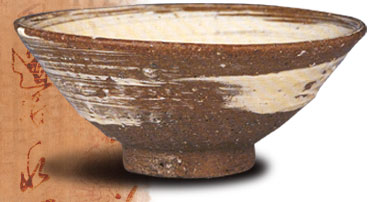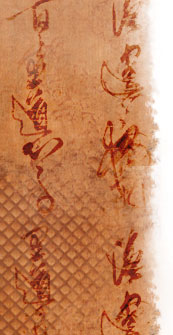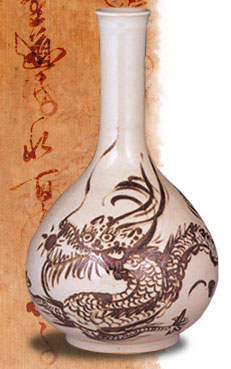 As a result, he entered another period of disappointment and embitterment, As a result, he entered another period of disappointment and embitterment,
 during which hated the world for its ignorance of the efforts and achievements
during which hated the world for its ignorance of the efforts and achievements
 he had made. Eventually, he got through his depression and began to think
he had made. Eventually, he got through his depression and began to think
 about the word, ‘tradition.’ He decided to start again, but this time tried to establish
about the word, ‘tradition.’ He decided to start again, but this time tried to establish
 what his grandfather and father had stood for by using the traditional methods,
what his grandfather and father had stood for by using the traditional methods,
 materials and tools they had utilized. He made bowls and dishes of all shapes and
materials and tools they had utilized. He made bowls and dishes of all shapes and
 sizes as his seniors might have made them if they had been alive, and entered some of
sizes as his seniors might have made them if they had been alive, and entered some of
 his pieces into a folk craft show the following year. The works received the Critic’s Choice
his pieces into a folk craft show the following year. The works received the Critic’s Choice
 Award ('Ipseon') and the judges commented that they reminded them of days gone by when
Award ('Ipseon') and the judges commented that they reminded them of days gone by when
 life was simpler and people were happier. The panel praised his artworks for the coarse texture
life was simpler and people were happier. The panel praised his artworks for the coarse texture
 of the sandy clay, the brilliance of the blue glaze, their simple but dynamic designs made by carefree
of the sandy clay, the brilliance of the blue glaze, their simple but dynamic designs made by carefree
brush strokes, as well as their voluminous form. They said his productions were a fine legacy of Joseon maksabal
(‘all-purpose bowl’) that beautifully reflects the simple life of the common people. They were, in short, an incarnation
of the glorious tradition that his family had maintained for approximately two centuries, despite great hardships and
adversity.
His faith and confidence returned at last, Kim concentrated his energy into reviving the
traditional Joseon ceramic ware his ancestors had created, and was awarded the
National Folk Craft Show‘s Special Prize in both 1988 and 1989. In 1991, he received
the honorary title of Myeongjang (‘Master Artist’), becoming the first potter to have been
bequeathed such a tribute. But the highest honor came in 1996 when he was
designated by the Korean government as Sagijang (‘Master Potter) of an ‘Important
Intangible Cultural Property,’ which corresponds to the UNESCO term, a ‘Living Human
Treasure.’
Even though titles and accolades have been bestowed on him, his life as a potter has
not changed at all. Like his ancestors, he begins and ends each day creating wonderful
masterpieces using age-old techniques and traditions that have been lovingly handed
down from father to son for many generations.
Kim Jeong-ok, who is also known by his penname, Baeksan (‘White Mountain’), is an
artist who knows how to make a ceramic bowl as affable and gracious as the earth
from which it is born. The Joseon white ceramics’ modesty and unpretentiousness
is one of its most beautiful, distinguishable traits; therefore, the pottery blesses
the common people to feel comfortable and relaxed using them. The secret is his
ability to infuse the purity of the earth and of tradition into his works. Thus, he employs
established methods and tools, for example, a mangdaengi gama, a Korean traditional
wood fired kiln that is made by building a domed tunnel with mushroom-shaped clay bricks.
This pottery kiln allows the flames to flow evenly within it, and can endure heat of more than 1,000
degrees Celsius for many years.
The use of Red- Pine to fire such a pottery kiln is another principle that has not changed for centuries and that Kim
Jeong-ok fervently follows to preserve the custom. By utilizing this special wood that produces superior flames and the
best conditions for firing, and thus adhering to unique and deep-rooted methods of tradition, he creates works of art just
as breathtaking as his ancestors.' He feels that once a piece of formed and molded clay leaves his hands, it is given
 over to the mysterious forces of nature that are beyond human capacity. As one who understands the firing process
over to the mysterious forces of nature that are beyond human capacity. As one who understands the firing process
 of oxidation and de-oxidation, he has no choice but to let the flames take control, to transform a lump of clay into
of oxidation and de-oxidation, he has no choice but to let the flames take control, to transform a lump of clay into
 a masterpiece.
a masterpiece.
 Actually, there is no scientific data to prove that Red Pine influences the quality of pottery. Like many secrets Actually, there is no scientific data to prove that Red Pine influences the quality of pottery. Like many secrets
 still kept in traditional folk crafts, the firing technique is heavily dependent on the potter’s knowledge gained
still kept in traditional folk crafts, the firing technique is heavily dependent on the potter’s knowledge gained
 through his experiences in his workshop. However, Red Pine does generate a stronger heat in the pottery kiln
through his experiences in his workshop. However, Red Pine does generate a stronger heat in the pottery kiln
 without leaving much ash behind, which, Kim Jeong-ok believes, helps gain the brilliant white he aspires
without leaving much ash behind, which, Kim Jeong-ok believes, helps gain the brilliant white he aspires
 in his ceramic works. Although a modern gas kiln is designed for the mass-production of pottery, it fails to
in his ceramic works. Although a modern gas kiln is designed for the mass-production of pottery, it fails to
 generate the subtle yet significant details on the surface of the ceramics that are created by a wood fired kiln.
generate the subtle yet significant details on the surface of the ceramics that are created by a wood fired kiln.
 He believes there is no basis for science in pottery-making because fire does not belong to science or mankind;
He believes there is no basis for science in pottery-making because fire does not belong to science or mankind;
 it is a product of nature and of God.
it is a product of nature and of God.
 Kim Jeong-ok fires his pottery kiln once every two Kim Jeong-ok fires his pottery kiln once every two
 months. The first firing normally lasts about 10 hours
months. The first firing normally lasts about 10 hours
 with the heat set at approximately 800 degrees Celsius, with the heat set at approximately 800 degrees Celsius,
 while the second firing, which takes place after
while the second firing, which takes place after
 glazing, lasts for about 12 hours with the heat kept
glazing, lasts for about 12 hours with the heat kept
 as high as 1,300 degrees Celsius. Yet after the
as high as 1,300 degrees Celsius. Yet after the
 firing process, only about 5% of the several hundred
firing process, only about 5% of the several hundred
 pieces he has made reaches perfection. Even if
pieces he has made reaches perfection. Even if
 there is only a slight fault in the color or weight,
there is only a slight fault in the color or weight,
 the potter will smash the ceramic: the potter’s
the potter will smash the ceramic: the potter’s
 standard of excellence is so high, a work that isn’t
standard of excellence is so high, a work that isn’t
 of the best quality is simply discarded.
of the best quality is simply discarded.
|




















